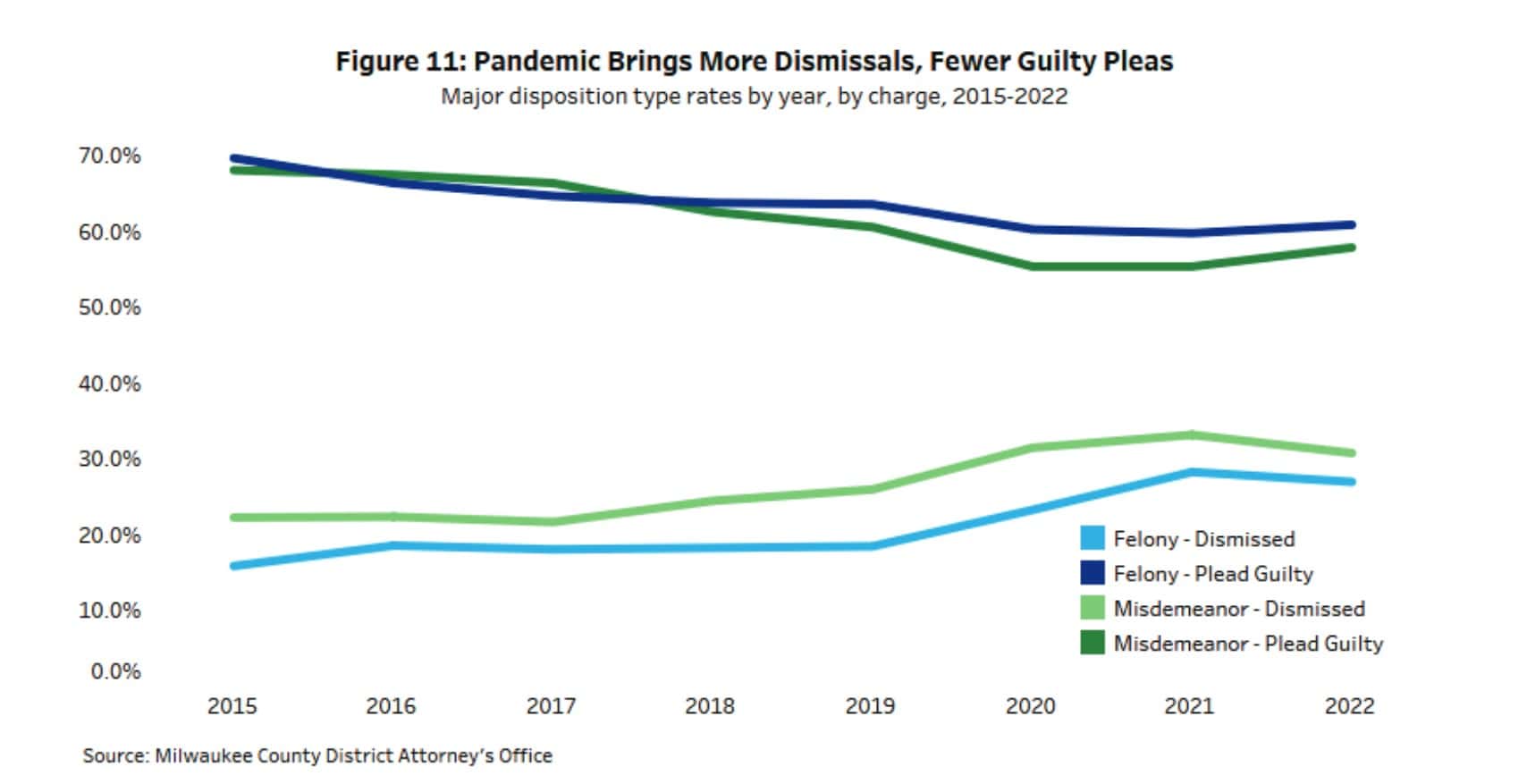PART SIX IN AN 11-PART SERIES. Read parts 1, 2, 3, 4 and 5.
Milwaukee County’s criminal justice system has broken down at almost all levels.
Although some of the breakdown can be attributed to the pandemic, some can not. Local officials’ questionable policy decisions also play a role, and it’s imperiling public safety. The pandemic exacerbated some already existing trends and caused others, but officials have not developed effective strategies to recover. Some non-pandemic-related issues, like the ACLU-related Collins Agreement’s impact on proactive policing and plummeting numbers of police officers (down 26% since 1996) have been largely overlooked in the media.
PROBLEM #6:
Once criminal cases hit court, defendants are more likely to have them dismissed than before the pandemic, and fewer cases are being resolved.
The number of criminal cases resolved in the court system plunged during the pandemic, but it has not fully rebounded. 12.6% fewer cases were resolved in 2022 than in 2019.
The percentage of criminal court cases DISMISSED has risen since before the pandemic. In 2022, dismissals for misdemeanor cases were 30.2%. That’s up 9% since 2017 but down since 2021. Dismissals for felony cases rose to 27% in 2022, up 11% since 2016 but down slightly from 2021.
The misdemeanor dismissal increases started as a trend before the pandemic. There were fewer guilty pleas, a trend that also started before the pandemic. Officials attribute the dismissal issues to court backlogs resulting in witnesses not being found or defendants not being willing to enter guilty pleas, which we explore in a future article.
 THE SERIES:
THE SERIES:
We have taken the lead in exploring the problems in Milwaukee County’s Criminal Justice system since our site launched in 2020, breaking stories on Milwaukee police staffing declines (which started years ago), the DA’s high non-prosecution rate and new reliance on summonses, the 2018 ACLU Collins Agreement’s deleterious effect on proactive policing, new jail and police policies restricting bookings and arrests, and the massive court backlogs, which leave defendants on the streets longer to re-offend and provoke constitutional concerns. Milwaukee is at a crisis point, with record homicide numbers and a severe reckless driving crisis.
Now, a new August 2023 report from the Wisconsin Policy Forum has examined Milwaukee County’s Criminal Justice System in great detail, providing fresh data from 2018 (before the pandemic) to 2022. We are excerpting some of the key statistical findings in our 11-part series to further understanding of the problem. You can’t formulate solutions if you don’t understand the problem’s scope. The few news articles that emerged only superficially skimmed over the report’s findings. The report’s authors are Rob Henken, Ari Brown, and Betsy Mueller.
Although the report deals with the context of the pandemic, it also makes it clear that, in some respects, trends imperiling public safety started before it or have continued, even escalating in some cases, in 2022, after its height. In other words, you can’t blame everything on the pandemic. The report also indicates that, in a number of ways, some problems that escalated during the pandemic have not been resolved by officials even as late as 2022. In other cases, progress has been made.
“Overall, this report has revealed that multiple key points of the justice system pipeline in Milwaukee County are not functioning in the same way or at the same level as they were prior to the pandemic,” the authors wrote. “It is now incumbent upon justice system leaders and state and local policymakers to aggressively explore why that is, to what degree it may have impacted public safety, what progress is being made in remedying the identified challenges, and whether additional resources or other solutions are required to get the system back on track.”
In each article, which we will run over the next 11 days at 7 a.m. every day, we will outline the problems and present the research. After that, we will run a wrap-up article suggesting solutions. What happens in the state’s largest county has an effect throughout Wisconsin. The WPF report was commissioned by the Milwaukee-based Argosy Foundation and the Milwaukee Community Justice Council (CJC). Most of it is focused on useful data. In cases where we think aspects were left out, we will note that. In this series, we hope to get past simplistic rhetoric (“it’s the state Legislature’s fault!” on the left or “who cares what happens in Milwaukee!” on the right.)
PROBLEM #6

Fewer criminal cases are being resolved in court, and cases are more likely to be dismissed than before the pandemic.
- “The number of cases that have been “resolved in court dropped significantly during the pandemic, and have not yet rebounded to pre-pandemic levels. In each year from 2015 to 2019, at least 11,740 cases were resolved each year, and in no month were fewer than 700 cases resolved. Given the disruption that occurred early in the pandemic, it is not surprising that monthly case resolutions fell to just 99 in April 2020, but they did
not get back above 700 in a month until March 2021.” - “In each year since the start of the pandemic, the number of resolved cases has grown. In fact, in 2022, only 12.6% fewer cases were resolved than in 2019 (as compared to 30.0% fewer cases in 2021 and 49.7% fewer cases in 2020.”
- “The proportion of misdemeanor cases that ended with a dismissal was rising noticeably prior to the pandemic and then continued to increase, from 21.7% in 2017 to 33.2% in 2021. Dismissals then fell slightly to 30.8% of resolved cases in 2022. It is also important to note that while misdemeanor dismissal rates were high at the very beginning of the pandemic – above 41% in April, May, and June 2020 – they returned to pre-pandemic levels quickly.”
- “Meanwhile, after staying consistently between 18% and 19% in each year from 2016 to 2019, dismissals for felony cases jumped significantly – to 23.3% in 2020 and again to 28.3% in 2021, then fell slightly to 27.0% in 2022.”
- “For both misdemeanors and felonies, higher percentages of dismissals intuitively correspond with lower percentages of guilty pleas. From 2015 to 2019, the percentage of felony cases that ended with a guilty plea declined from 69.7% to 63.6%, before dropping further to 60.3% in 2020 and 59.8% in 2021. In 2022, for the first year in the available data, they increased (to 60.9%).”
Table of Contents


![Mandela Barnes Said ‘Reducing Prison Populations is Now Sexy’ [VIDEO] Reducing Prison Populations is Now Sexy](https://www.wisconsinrightnow.com/wp-content/uploads/2022/09/Collage-Maker-14-Sep-2022-11.44-AM-265x198.jpg)







![Author Exposes the Tragic Realities of the 2020 Riots & the ‘Gaslighting of America’ [REVIEW] julio roses](https://www.wisconsinrightnow.com/wp-content/uploads/2025/11/MixCollage-21-Nov-2025-02-08-PM-8145-265x198.jpg)

